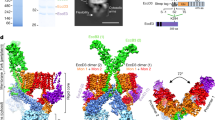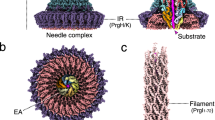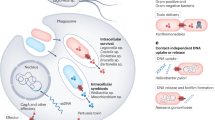Abstract
During infection by Gram-negative pathogenic bacteria, the type III secretion system (T3SS) is assembled to allow for the direct transmission of bacterial virulence effectors into the host cell1. The T3SS system is characterized by a series of prominent multi-component rings in the inner and outer bacterial membranes, as well as a translocation pore in the host cell membrane. These are all connected by a series of polymerized tubes that act as the direct conduit for the T3SS proteins to pass through to the host cell. During assembly of the T3SS, as well as the evolutionarily related flagellar apparatus2, a post-translational cleavage event within the inner membrane proteins EscU/FlhB is required to promote a secretion-competent state. These proteins have long been proposed to act as a part of a molecular switch, which would regulate the appropriate chronological secretion of the various T3SS apparatus components during assembly and subsequently the transported virulence effectors. Here we show that a surface type II β-turn in the Escherichia coli protein EscU undergoes auto-cleavage by a mechanism involving cyclization of a strictly conserved asparagine residue3. Structural and in vivo analysis of point and deletion mutations illustrates the subtle conformational effects of auto-cleavage in modulating the molecular features of a highly conserved surface region of EscU, a potential point of interaction with other T3SS components at the inner membrane. In addition, this work provides new structural insight into the distinct conformational requirements for a large class of self-cleaving reactions involving asparagine cyclization.
This is a preview of subscription content, access via your institution
Access options
Subscribe to this journal
Receive 51 print issues and online access
$199.00 per year
only $3.90 per issue
Buy this article
- Purchase on Springer Link
- Instant access to full article PDF
Prices may be subject to local taxes which are calculated during checkout



Similar content being viewed by others
References
Hueck, C. J. Type III protein secretion systems in bacterial pathogens of animals and plants. Microbiol. Mol. Biol. Rev. 62, 379–433 (1998)
Macnab, R. M. How bacteria assemble flagella. Annu. Rev. Microbiol. 57, 77–100 (2003)
Ferris, H. U. & Minamino, T. Flipping the switch: bringing order to flagellar assembly. Trends Microbiol. 14, 519–526 (2006)
Sorg, I. et al. YscU recognizes translocators as export substrates of the Yersinia injectisome. EMBO J. 26, 3015–3024 (2007)
Lavander, M. et al. Proteolytic cleavage of the FlhB homologue YscU of Yersinia pseudotuberculosis is essential for bacterial survival but not for type III secretion. J. Bacteriol. 184, 4500–4509 (2002)
Ding, Y. et al. Crystal structure of a mini-intein reveals a conserved catalytic module involved in side chain cyclization of asparagine during protein splicing. J. Biol. Chem. 278, 39133–39142 (2003)
Paulus, H. Protein splicing and related forms of protein autoprocessing. Annu. Rev. Biochem. 69, 447–496 (2000)
Shemella, P. et al. Mechanism for intein C-terminal cleavage: a proposal from quantum mechanical calculations. Biophys. J. 92, 847–853 (2007)
Geiger, T. & Clarke, S. Deamidation, isomerization, and racemization at asparaginyl and aspartyl residues in peptides. Succinimide-linked reactions that contribute to protein degradation. J. Biol. Chem. 262, 785–794 (1987)
Stephenson, R. C. & Clarke, S. Succinimide formation from aspartyl and asparaginyl peptides as a model for the spontaneous degradation of proteins. J. Biol. Chem. 264, 6164–6170 (1989)
Clarke, S. Propensity for spontaneous succinimide formation from aspartyl and asparaginyl residues in cellular proteins. Int. J. Pept. Protein Res. 30, 808–821 (1987)
Hodges, J. A. & Raines, R. T. Energetics of an n → π* interaction that impacts protein structure. Org. Lett. 8, 4695–4697 (2006)
Ferris, H. U. et al. FlhB regulates ordered export of flagellar components via autocleavage mechanism. J. Biol. Chem. 280, 41236–41242 (2005)
Fraser, G. M. et al. Substrate specificity of type III flagellar protein export in Salmonella is controlled by subdomain interactions in FlhB. Mol. Microbiol. 48, 1043–1057 (2003)
Zarivach, R., Vuckovic, M., Deng, W., Finlay, B. B. & Strynadka, N. C. Structural analysis of a prototypical ATPase from the type III secretion system. Nature Struct. Mol. Biol. 14, 131–137 (2007)
Otwinowski, Z. & Minor, W. Processing of X-ray diffraction data collected in oscillation mode. Macromol. Crystallogr. A 276, 307–326 (1997)
Schneider, T. & Sheldrick, G. Substructure solution with SHELXD. Acta Crystallogr. D 58, 1772–1779 (2002)
Emsley, P. & Cowtan, K. Coot: model-building tools for molecular graphics. Acta Crystallogr. D 60, 2126–2132 (2004)
Murshudov, G. N., Vagin, A. A. & Dodson, E. J. Refinement of macromolecular structures by the maximum-likelihood method. Acta Crystallogr. D 53, 240–255 (1997)
McCoy, A. J., Grosse-Kunstleve, R. W., Storoni, L. C. & Read, R. J. Likelihood-enhanced fast translation functions. Acta Crystallogr. D 61, 458–464 (2005)
PyMOL. v.1 (DeLano Scientific, Palo Alto, California, 2002)
Baker, N. A., Sept, D., Joseph, S., Holst, M. J. & McCammon, J. A. Electrostatics of nanosystems: application to microtubules and the ribosome. Proc. Natl Acad. Sci. USA 98, 10037–10041 (2001)
Edwards, R. A., Keller, L. H. & Schifferli, D. M. Improved allelic exchange vectors and their use to analyze 987P fimbria gene expression. Gene 207, 149–157 (1998)
Deng, W. et al. Dissecting virulence: systematic and functional analyses of a pathogenicity island. Proc. Natl Acad. Sci. USA 101, 3597–3602 (2004)
Datsenko, K. A. & Wanner, B. L. One-step inactivation of chromosomal genes in Escherichia coli K-12 using PCR products. Proc. Natl Acad. Sci. USA 97, 6640–6645 (2000)
Maloy, S. & Nunn, W. Selection for loss of tetracycline resistance by Escherichia coli . J. Bacteriol. 145, 1110–1112 (1981)
Kimbrough, T. G. & Miller, S. I. Contribution of Salmonella typhimurium type III secretion components to needle complex formation. Proc. Natl Acad. Sci. USA 97, 11008–11013 (2000)
Pegues, D. A., Hantman, M. J., Behlau, I. & Miller, S. I. PhoP/PhoQ transcriptional repression of Salmonella typhimurium invasion genes: evidence for a role in protein secretion. Mol. Microbiol. 17, 169–181 (1995)
Acknowledgements
We thank T.S., M.C. and P.I.L. for discussions; the staff at the Advanced Light Source beamline 8.2.2 and SSRL beamline 11-1 for data collection time and assistance; and E. Galyov at the Institute for Animal Health for the SipA, SipB and SipC antibodies. This work was supported by an Izaak Walton Killam Research post-doctoral fellowship, a Michael Smith Foundation for Health Research (MSFHR) post-doctoral fellowship and a Canadian Institutes of Health Research (CIHR) post-doctoral fellowship (all to R.Z.). N.C.J.S. and B.B.F. thank the Howard Hughes International Scholar program and the CIHR for funding. N.C.J.S. also thanks the MSFHR and the Canada Foundation of Innovation for infrastructure funding support. N.C.J.S. is also an MSFHR Senior Scholar and CIHR Investigator. S.M. acknowledges grants from the National Institutes of Allergy and Infectious Diseases (NIAID), U54 AI057141 and 5RO1 AI030479.
Author Contributions R.Z. and M.V. cloned and purified EscU and SpaS. R.Z. crystallized EscU and SpaS. R.Z. solved the structures. H.B.F. isolated the chromosomal SpaS mutants. W.D., H.B.F and H.V.N. performed the biochemical experiments in Fig. 2. B.B.F. and S.I.M. provided resources for the experiments shown in Fig. 2. N.C.J.S. provided resources for all data other than those in Fig. 2. All authors discussed the results and commented on the manuscript.
Author information
Authors and Affiliations
Corresponding author
Supplementary information
Supplementary Information
The file contains Supplementary Tables 1-2 and Supplementary Figures 1-13 with Legends. The Supplementary Tables describe the crystallization and the structure determination statistics. The Supplementary Figures describe additional biochemical data, structural analysis and circular dichroism experiments. (PDF 2401 kb)
Rights and permissions
About this article
Cite this article
Zarivach, R., Deng, W., Vuckovic, M. et al. Structural analysis of the essential self-cleaving type III secretion proteins EscU and SpaS. Nature 453, 124–127 (2008). https://doi.org/10.1038/nature06832
Received:
Accepted:
Issue Date:
DOI: https://doi.org/10.1038/nature06832
This article is cited by
-
The substrate specificity switch FlhB assembles onto the export gate to regulate type three secretion
Nature Communications (2020)
-
Type three secretion system in Salmonella Typhimurium: the key to infection
Genes & Genomics (2020)
-
Cryo-EM analysis of the T3S injectisome reveals the structure of the needle and open secretin
Nature Communications (2018)
-
Molecular dynamics simulation of bacterial flagella
Biophysical Reviews (2018)
-
Supplemental invasion of Salmonella from the perspective of Salmonella enterica serovars Kentucky and Typhimurium
BMC Microbiology (2017)
Comments
By submitting a comment you agree to abide by our Terms and Community Guidelines. If you find something abusive or that does not comply with our terms or guidelines please flag it as inappropriate.



